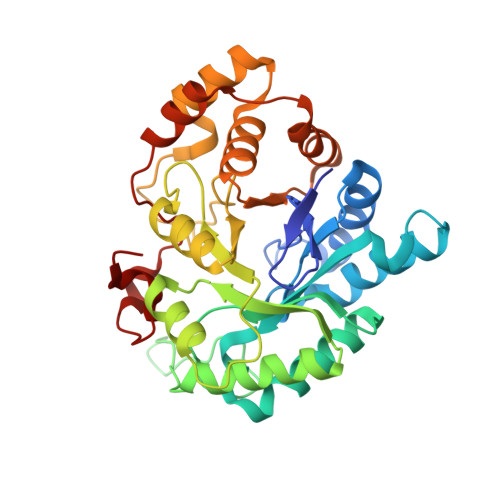Prostaglandin F2alpha formation from prostaglandin H2 by prostaglandin F synthase (PGFS): crystal structure of PGFS containing bimatoprost.
Komoto, J., Yamada, T., Watanabe, K., Woodward, D.F., Takusagawa, F.(2006) Biochemistry 45: 1987-1996
- PubMed: 16475787
- DOI: https://doi.org/10.1021/bi051861t
- Primary Citation of Related Structures:
2F38 - PubMed Abstract:
Prostaglandin H(2) (PGH(2)) formed from arachidonic acid is an unstable intermediate and is efficiently converted into more stable arachidonate metabolites by the action of enzymes. Prostaglandin F synthase (PGFS) has dual catalytic activities: formation of PGF(2)(alpha) from PGH(2) by the PGH(2) 9,11-endoperoxide reductase activity and 9alpha,11beta-PGF(2) (PGF(2)(alphabeta)) from PGD(2) by the PGD(2) 11-ketoreductase activity in the presence of NADPH. Bimatoprost (BMP), which is a highly effective ocular hypotensive agent, is a PGF(2)(alpha) analogue that inhibits both the PGD(2) 11-ketoreductase and PGH(2) 9,11-endoperoxide reductase activities of PGFS. To examine the catalytic mechanism of PGH(2) 9,11-endoperoxide reductase, a crystal structure of PGFS[NADPH + BMP] has been determined at 2.0 A resolution. BMP binds near the PGD(2) binding site, but the alpha- and omega-chains of BMP are locate on the omega- and alpha-chains of PGD(2), respectively. Consequently, the bound BMP and PGD(2) direct their opposite faces of the cyclopentane moieties toward the nicotinamide ring of the bound NADP. The alpha- and omega-chains of BMP are involved in H-bonding with protein residues, while the cyclopentane moiety is surrounded by water molecules and is not directly attached to either the protein or the bound NADPH, indicating that the cyclopentane moiety is movable in the active site. From the complex structure, two model structures of PGFS containing PGF(2)(alpha) and PGH(2) were built. On the basis of the model structures and inhibition data, a putative catalytic mechanism of PGH(2) 9,11-endoperoxide reductase of PGFS is proposed. Formation of PGF(2)(alpha) from PGH(2) most likely involves a direct hydride transfer from the bound NADPH to the endoperoxide of PGH(2) without the participation of specific amino acid residues.
Organizational Affiliation:
Department of Molecular Biosciences, University of Kansas, 1200 Sunnyside Avenue, Lawrence, Kansas 66045-7534, USA.
















